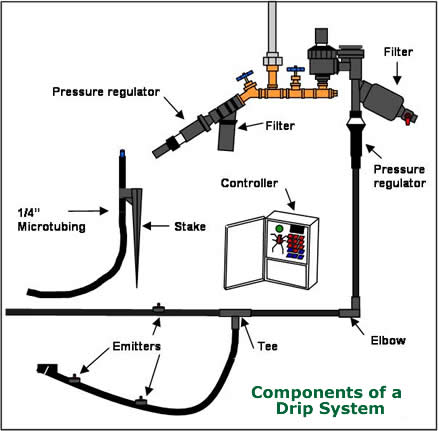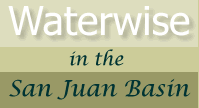Principle #4
Apply Irrigation Water Efficiently
Strategies for More Efficient
Irrigation
Waterwise gardening should emphasize a wide range of
water conservation practices without shortchanging plants
on their water needs. Some of the ways in which watering
can be made more efficient are:
Water early in the day. Or water at night
to minimize the water lost through evaporation. Also,
the winds tend to be less in the early morning hours.
Water deeply and thoroughly. Most plants
tend to develop roots that spread through the soil
to the depth where water, air and nutrients are available.
Light watering does not encourage deep root growth,
and because the soil dries from the top down, it requires
more frequent watering.
Eliminate runoff. One of the most basic
strategies for eliminating runoff is to water accurately.
Overspray onto paved surfaces contributes nothing
to your landscape or to the conservation objective.
Heavy clay soils or sloping lands can also lead to
excessive runoff. To counteract these conditions,
either change your design or water for several successive
short intervals to allow the water to soak in.
Use low-volume watering devices. If you
already have an underground sprinkler system, you
can increase its efficiency by changing the heads
to a low-precipitation type head. Use matched precipitation
rate heads to ensure even water application. Also
convert as many zones as possible to drip zones with
ultra-low volume heads.
Change your watering schedules seasonally. Water
demands will vary according to seasonal temperatures
and seasonal precipitation patterns. Adjust your watering
routines to account for cooler temperatures and current
precipitation.
Use an automated watering system. Monitoring
water application with hose sprinklers to ensure even
coverage and run times is a difficult task to accomplish
with any degree of consistency. Accidentally leaving
a sprinkler running overnight can waste thousands
of gallons of water. Most people do not have the time
required to accomplish the job in an acceptable manner.
The use of an automatic electronic water controller
can operate complex or simple watering routines exactly
when and how long you want. This is especially helpful
for summer vacations.
|
Drip Irrigation Systems
The use of a drip irrigation system is one of
the easiest ways to more precisely monitor the
amount of water applied to your landscape. It
is also one of the easiest systems to assemble
and adjust. A drip system will deliver water at
low pressure to specific areas or plants. Water
penetration is slow and the depth of penetration
is determined by the amount of time the system
is run. A drip system can be added to an existing
underground system, or it can be run directly
from a hose bibb or the end of a hose. A key component
of a drip system is the pressure regulator. Most
drip systems are designed to be operated between
20– 30 psi. Most household water lines may
be much higher than this. The pressure regulator
will reduce the pressure to a rate that the system
can handle.

Irrigation Tip
Inexpensive automatic timers that attach directly
to your hose bibbs are available through local
hardware stores. The timers can be used for drip
systems or for lawn sprinklers and may be
programmed
for four or more start times per day.
|
|

